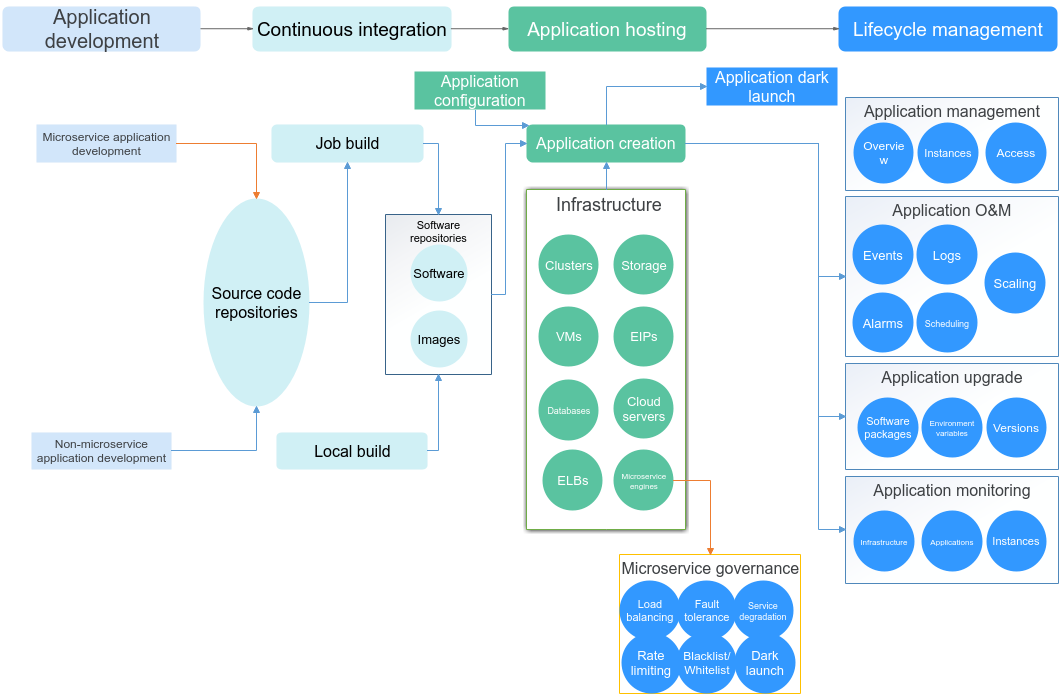Before You Start
ServiceStage is an application management and O&M platform that lets you deploy, roll out, monitor, and maintain applications all in one place. It supports technology stacks such as Java, PHP, Python, Node.js, Docker, and Tomcat, and supports microservice applications such as Apache ServiceComb Java Chassis (Java chassis) and Spring Cloud, making it easier to migrate enterprise applications to the cloud.
This document describes how to use ServiceStage to create, deploy, and maintain application components and perform service governance.
Usage Description
Figure 1 describes how to create and deploy application components on ServiceStage and how to perform application O&M and service governance.
- Before using ServiceStage, register a Huawei Cloud account and grant permissions to use ServiceStage. For details, see Prerequisites.
- Before using ServiceStage to create and deploy application components, you need to develop applications. For details, see ServiceStage Developer Guide.
- Before using ServiceStage, log in to the ServiceStage console. For details, see Logging In to ServiceStage.
- For details about the ServiceStage console, see Console Description.
- For details about the ServiceStage versions, see Product Versions.
- For details about how to upgrade a ServiceStage version, see Upgrading Product Versions.
- To use ServiceStage functions, such as project build and release, for continuous application integration, see Continuous Delivery.
- To use ServiceStage to create environments and create and deploy components for application hosting and lifecycle management, see:
Prerequisites
- You have registered a Huawei account and enabled Huawei Cloud services.
- The login account has the permission to use ServiceStage. For details, see Creating a User and Granting ServiceStage Permissions.
Logging In to ServiceStage
- Log in to the management console.
- Click
 and select a region.
and select a region. - Click
 in the upper left corner, and click ServiceStage.
in the upper left corner, and click ServiceStage.
- If you log in for the first time, click Authorize on the displayed service authorization page to authorize ServiceStage to use the services on which it depends. Then, the ServiceStage console is displayed.
- If this is not your first login, the ServiceStage console is displayed directly.
Console Description
Table 1 describes ServiceStage console.
|
Module |
Description |
|---|---|
|
Overview |
The Overview page provides a dashboard, including ServiceStage edition selection, total number of environments, applications, and components, monitoring information, alarms, and documentation.
|
|
Environment Management |
An environment is a collection of compute, network, and middleware resources used for deploying and running a component. The Environment Management page allows you to create, edit, and delete environments, and configure resources (manage and remove resources). Created environments are displayed in a list. |
|
Application Management |
An application is a service system with complete functions and consists of one or more components related to features. The Application Management page allows you to create, edit, and delete applications. Created applications and the number of components created under them are displayed in a list, and entries for creating components under applications are available. |
|
Component Management |
A component is a service feature implementation of an application. It is carried by code or software packages and can be independently deployed and run. The Component Management page displays components of all applications in a list, and provides the component details page as well as the entries for component creation and O&M. |
|
Configuration Management |
In ServiceStage, a configuration is a file. You can fill the environment and application system variables (such as the IP address, port number, database address, and application name associated with the environment) in a configuration file. When the component is associated with the configuration for deployment, the system variables are automatically replaced with the actual values. This implements multi-environment use with one-time configuration through file mounting. The Configuration Management page allows you to create, edit, and delete configurations. Created configurations are displayed in a list. |
|
Release Management |
Release tasks of different types provide functions for releasing applications: single-component release, batch operations (release, upgrade, and clone), and dependency-based orchestration. This feature enables you to flexibly deploy components in batches, improving service efficiency and user experience. This page displays created release tasks and provides entries for creating and managing release tasks. |
|
Tech Stack Management |
Provides an entry for customizing technology stack versions to provide multiple runtime systems. It also provides entries for starting, stopping, editing, and deleting technology stack versions. |
|
Deployment Source Management |
Provides functions such as organization management, software repository, and image repository.
|
|
Continuous Delivery |
Provides functions such as viewing build projects, releasing build projects, and authorizing repositories.
|
|
Cloud Service Engine |
Provides operation entries for engine instance management, dashboard usage, microservice catalog management, microservice governance, configuration management, and system management. |
Product Versions
Log in to the ServiceStage console and select an edition on the Overview page. Currently, ServiceStage provides basic edition and professional edition.
|
Edition |
Package Description |
|---|---|
|
Basic |
20 instances are free of charge. A maximum of 100 instances are supported. |
|
Professional |
More than 100 instances are supported. |
Upgrading Product Versions
- Log in to ServiceStage and go to the Overview page.
- On the right of the Overview page, click
 next to Edition.
next to Edition. - Select a product version and click OK.

Only the account administrator can upgrade a package.
For the definitions of an account and IAM user, see Basic Concepts.
Feedback
Was this page helpful?
Provide feedbackThank you very much for your feedback. We will continue working to improve the documentation.See the reply and handling status in My Cloud VOC.
For any further questions, feel free to contact us through the chatbot.
Chatbot







